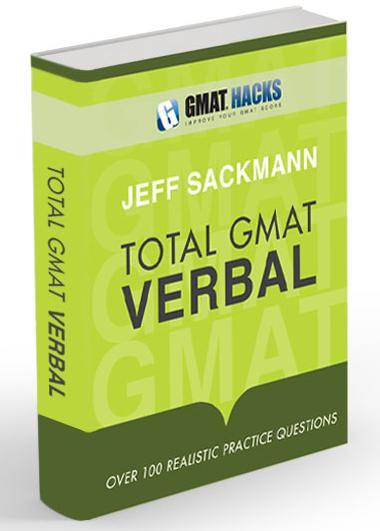
Bookshelf
|
|
Total GMAT Math Jeff's complete Quant guide, on sale now! |
|
|
Total GMAT Verbal Everything you need to ace GMAT Verbal! |
1,800 Practice Math Questions
Buy Jeff's books at Amazon.com

GMAT Official Guide, with IR
OG Math | OG Verbal
OG12 & Quant Rev solutions!
GMAT Question of the Day
Beginner's Guide to the GMAT
GMAT Hacks Affiliate Program

Recent Hacks

Categories
- General Study Tips
- Goals and Planning
- CAT Strategy
- The Mental Game
- GMAT Math Strategy
- GMAT Math Topics
- Mental Math
- Data Sufficiency
- Critical Reasoning
- Reading Comprehension
- Sentence Correction
- Analytical Writing Assessment
- Integrated Reasoning
- IR Explained
- Business School Admissions
- GMAT Prep Resources
- Practice Questions
- Total GMAT Math
- Total GMAT Verbal
- GMAT 111

GMAT Reading Comprehension (Beginner's Guide)
| You should follow me on Twitter. While you're at it, take a moment to subscribe to GMAT Hacks via RSS or Email. |
Note: Today's article is the third in a series I'm running throughout January and February called "The Beginner's Guide to the GMAT." Here are parts one and two.
GMAT Reading Comprehension is somewhat similar to GMAT Critical Reasoning in that you read a passage and answer some questions about it. I'm assuming most readers have taken standardized tests before, and you're familiar with the basic format of a several-paragraph passage followed by a few test items.
There are two main differences between CR and RC. The first is obvious: RC passages are longer. They vary in length quite a bit, but you can expect to see passages between about 200 and 400 words. Some will consist of two long paragraphs; others will broken up into four or five short paragraphs.
Because the passages are longer, they can be quite a bit more involved. The shorter CR passages can use unfamiliar, technical language, but there's very little to understand in a three-sentence argument. In Reading Comprehension, however, you can be thrown into an unfamiliar topic and be expected to answer complicated questions about anything from physics to archaeology to the history of economics.
Reading Comprehension Questions
The fact that the passage is longer and more involved influences the other main difference between RC and CR: the types of questions. In Critical Reasoning, the questions are almost always focused on some aspect of an argument. You'll see that in RC, too, but not nearly as much.
In fact, there's a wide variety of questions on Reading Comprehension passages. There are a number of ways they can be broken down, but I'll offer four categories:
- Topic: This is the old standard, "What is the main idea of the passage?" The GMAT has numerous ways of asking this--you'll probably come across at least a half-dozen. The key is to find the answer choice that not only matches the topic (say, the excavation of Mayan ruins), but also the specific focus of the passage (perhaps a controversy about proper excavation methods).
- Detail: These usually come with the phrase, "According to the passage," or something similar. The answer is just a reworded version of something in the passage. Here, the GMAT is testing whether you read the passage and understood the structure well enough to find a specific detail that you may not have remembered.
- Analysis: There aren't very many assumption and strengthen/weaken questions in RC, but there are plenty of inference questions. Often, the GMAT expects you to grasp the differences between different viewpoints on the same issue, or determine which parts of the passage are the author's opinion and which parts are fact.
- Structure: These are less common but don't fit into any of the other three paragraphs. You might be asked how a certain sentence functions, or what the purpose of one of the paragraphs is. RC Structure questions are not too far removed from the bold-face items in Critical Reasoning.
Reading Comprehension Tips and Tricks
Nearly everyone finds it beneficial to take notes while reading RC passages. Exactly how you do that will depend on what works best for you. I prefer to jot down a sentence or two at the end of each paragraph, if only to keep myself focused and prevent my mind from wandering. (These topics aren't exactly thrilling!)
Pay particular attention to structure and scope. The structure gives you clues to the author's argument, and his or her method of establishing it. Is she describing two theories only to reject both? Defending a position and holding off competitors? The structure of RC passages is usually quite plain in this regard.
"Scope" refers to the passage's specific focus. While it is rare that the GMAT will explicitly test your knowledge of a passage's scope, it will come up in at least one question on nearly every passage. Make sure you understand not only what the author has chosen to address, but what she has chosen to leave out. There's only so much you can write in four or five paragraphs, so GMAT passages are typically very focused.
Further Reading
One-third of my book, Total GMAT Verbal, is devoted to Reading Comprehension. It breaks down passage topics, passage structures, question types, and common wrong answer choices--and it provides dozens of realistic practice questions. Also, on the site, I've written several articles on Reading Comprehension strategy, especially on the types of passages. Here is a list of those articles.
About the author: Jeff Sackmann has written many GMAT preparation books, including the popular Total GMAT Math, Total GMAT Verbal, and GMAT 111. He has also created explanations for problems in The Official Guide, as well as 1,800 practice GMAT math questions.
 |
Total GMAT Verbal
The comprehensive guide to the GMAT Verbal section. Recognize, dissect, and master every question type
you'll face on the test. Everything you need, all in one place, including 100+ realistic practice questions. |